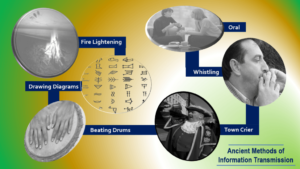Back to: Computer Studies JSS1
Welcome to class!
In today’s class, we shall be talking about drawing diagrams and making representations as an ancient method of transmitting information. Please enjoy the class!
Ancient Methods of Transmitting Information – drawing diagrams and making representations

Before the invention of writing and advanced communication systems, humans relied on various creative methods to transmit information across time and distance. One such method was through the use of diagrams and representations. These visual forms of communication played a crucial role in preserving knowledge, sharing stories, and marking significant events.
- Cave Paintings and Rock Art:
Considered one of the earliest forms of communication, cave paintings and rock art date back tens of thousands of years. These vivid depictions of animals, hunting scenes, and abstract symbols served as a way for early humans to share information about their environment, beliefs, and rituals.
- Pictograms and Ideograms:
These early forms of writing used simple pictures or symbols to represent objects, concepts, and actions. Pictograms, like those used by the ancient Egyptians, directly resemble the objects they depict. Ideograms, on the other hand, represent more abstract ideas, such as emotions or actions.
- Knotted Cords and String:
Known as quipus in the Inca Empire and wampum belts in North America, knotted cords and strings served as a complex system of record-keeping and communication. The arrangement and colors of knots could encode information about numbers, events, and even stories.
- Maps and Charts:
Early maps, drawn on animal skins or bark, depicted geographic features and helped people navigate their surroundings. These maps often incorporated symbols and illustrations to represent landmarks, resources, and dangers.
- Symbolic Representations:
Throughout history, various cultures have used symbolic representations to communicate cultural values, beliefs, and social hierarchies. These symbols could be found on clothing, jewelry, and even everyday objects, conveying information without the need for written language.
Significance of Diagrams and Representations:
Preserved Knowledge and History: Diagrams and representations served as a vital tool for preserving knowledge and history across generations. They allowed information to be passed down without the need for literacy, ensuring cultural continuity.
Facilitation of Communication: These visual aids provided a common language for diverse groups who may not have shared a spoken language. They facilitated communication in trade, diplomacy, and cultural exchange.
Spark of Innovation: The development of diagrams and representations laid the foundation for the invention of writing systems and other communication technologies. They represent the human desire to record and share information, a driving force in technological advancement.
Although overshadowed by modern communication methods, diagrams and representations remain a powerful tool for conveying information. They offer a unique way to communicate complex ideas, engage audiences, and connect with people across cultural and linguistic barriers. By studying these ancient methods, we gain a deeper appreciation for human ingenuity and the evolution of communication throughout history.
We have come to the end of today’s class. I hope you enjoyed the class!
In case you require further assistance or have any questions, feel free to ask in the comment section below, and trust us to respond as soon as possible. Cheers!
Question Time:
- Evaluate the role of drawings and representations in preserving and transmitting information across generations.
- Analyze the specific techniques used in smoke signals and drum communication. How were they able to encode complex information?
- Compare and contrast the advantages and limitations of oral communication vs. using messengers for long-distance information transmission.
